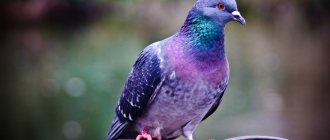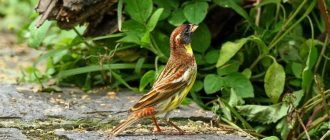If the competition were held, the most beautiful bird in the world, the peacock, would, without any doubt, take first place. The wealth of colors that the peacock wants to show off at every opportunity is a delight to the eye.
The first time you meet a peacock, you will get an unforgettable experience that will last a lifetime. Grace in every step, and a variety of colors that strive to outshine everyone around.
With all the unusually noble external characteristics, who would have thought that the peacock belongs to close relatives of the chicken family. Compare an ordinary chicken and a peacock. This fact of kinship does not fit into the head, but it is true.
Basic information
Despite the genetic component (the order Galliformes), it was once the peacock that became the prototype of the fabulous firebird for its unique appearance. Although they spend most of their time on the ground, they can fly beautifully. They feed on food of plant and animal origin, adore snakes and mollusks.
A large, fluffy tail is the prerogative of males. It appears before the start of the mating season, and after successful mating, the regrown feathers immediately fall off. Such a colorful instrument is necessary for peacocks to attract the opposite sex, as protection, and as a prerogative among competitors.
Most birds are polygamous: a family consists of one male and several females. The exception is African birds. They create strong monogamous unions once in a lifetime. There are only a few species of peacocks found in the wild:
- Indian or ordinary;
- white or albino;
- African or Congolese;
- Javanese or green.
Each of them lives in a specific halo and has a number of subspecies, differing in feather colors and anatomical features of the body. Unfortunately, most of the current varieties of peacocks are artificial, bred by breeders, and found only in private zoos.
Fact! Despite the fact that the peacock is a tropical inhabitant, it tolerates extreme cold well and quickly gets used to human society.
Habitat
The peacock belongs to the pheasant family and belongs to the order Galliformes. That's why it is also called the big chicken. And yet, where do peacocks live? It is known that the main habitat of peacocks is India and Sri Lanka. It was here that the common peacock, or, as it is also called, the Indian peacock, was first discovered. This species is the most common today - it can be observed in almost all zoos in the world.
Another species of peacock lives on the island of Java, the Malay Peninsula and Indochina. This species is called gigantic or Javanese. It is much larger than usual and has a brighter color. It must be said that there are about 50 species of peacocks. They are all different in size, but the males have a magnificent tail, which classifies them as this species.
Distribution history
This amazing bird was first seen by the Dutch who reached the islands in the Pacific Ocean. When they arrived back, they told an amazing story about a bird of paradise with a magnificent tail. Naturally, these stories raised a lot of questions. Where do peacocks live? In which country can they be seen? The discoverers of India were followed by traders who brought unusual birds. Interestingly, the first mention of these creatures is found in ancient scrolls, including the Bible. These birds decorated the magnificent palaces of the powerful rulers of Ancient Egypt, Rome and India, and were also the pride of the richest and wisest king in the history of mankind - Solomon. Peacocks came to Europe during the time of Alexander the Great, famous for his aggressive campaigns in the countries where peacocks live.
Ordinary
The most common type of peacock is called Indian, because of the halo of their habitat. In addition to India, birds can live in Pakistan, Nepal and Bangladesh, and Sri Lanka.
Peculiarities:
- blue-green tint of feathers on the back;
- the upper part of the body is a bright blue shade, iridescent green in bright sunlight;
- the fan smells black;
- the tail is brown, and the feathers above it are green; in the sun they acquire a bronze tint;
- the beak is pink with a dark, grayish tint.
Fact! Common peacocks have a very unpleasant, overly loud cry.
The length of the body, as well as the feathers on the tail, reaches almost 2 m. With proper care, birds of this species grow in carcasses up to 5 kg.
Females look noticeably smaller, although it is easier to distinguish them in pairs by the color of their plumage - it is less bright, not so expressive. Female peacocks have a small body length - 1 m. The lateral areas of the head and neck are painted white, while the tone of the chest and entire back is brown with a greenish tint.
It is the Indian, or common peacock, that has many varieties. The most famous of them:
- purple;
- midnight;
- opal;
- cameo;
- motley;
- white peephole;
- peach;
- varnished;
- lavender and others.
The common peacock is the easiest to find in the wild. They never let people get close to them, and in case of danger they prefer to fly away rather than spread their tail, as many are accustomed to thinking.
Where are birds most often found?
The most common habitats are countries such as: Pakistan, India, Bangladesh, Nepal, Sri Lanka. They are comfortable in areas located at least 2 km above sea level.
Jungles, forests, bushes, river banks are the places where this amazingly beautiful bird lives best.
The main thing is that there are no dense thickets. But they don’t know how to live in open areas.
White peacock
Despite their uniqueness, birds of this species have gained enormous popularity in the world in recent years. Peacocks of this color are called albinos, although this is not at all true: the white color of their feathers is their species feature, and not a gene mutation. That's why birds have blue eyes, not red.
The legs of males are longer than those of females, and the body is completely covered with light feathers. The pattern on the tail is faintly visible, but up close you can clearly see the notorious “eye”.
Peculiarities:
- tail length up to 0.5 m;
- there is a crest on the head;
- the wings, like the legs, are a little short;
- tail feathers reach 1.7 m.
Attention! Until 2 years of age, it is impossible to distinguish a male white peacock from a female. The only difference is the length of the legs (guys are taller).
Despite their direct relationship to the order Galliformes, white-feathered peacocks are not divided into other subspecies in the wild. Only selection has made it possible for scientists to develop several varieties of these birds with interesting colors:
- main – coal, midnight, purple, stone;
- secondary – silvery, white eye.
White peacocks prefer to live near ponds, swamps, near tall bushes or trees, where they spend the night. They are easy to domesticate, which is why in recent years they have become frequent newcomers to zoos.
Population and species status
Common peacocks, compared to some other species of birds, belong to the category of birds that does not cause any concern. This is evidence that the total number of such birds living in the natural environment is at an optimal level. This species is the most common, and in some areas quite numerous. The total number of peacocks in the wild is estimated at 100 thousand individuals. Despite this, the national bird of India is listed as an endangered species, as evidenced by the International Union for Conservation of Nature.
African, Congolese peacock
From the name it is clear that this species of bird is found in the forests of Zaire, next to the Congo River. Males do not have a recognizable plume of feathers, so gender characteristics are minimally expressed.
Peculiarities:
- red feathers on the neck;
- body length up to 70 cm;
- a crest on the head consisting of erect feathers;
- The color of the plumage in males is green with a bronze tint, in females - with a metallic tint;
- the head is almost bald;
- the beak is slightly bluish.
Fact! Due to the small population of African peacocks, they are listed in the Red Book.
Some interesting facts
- The national symbol of Burma is the peacock.
- In the Middle Ages, birds' feathers were used to decorate hats, dresses, and knight's helmets.
- The bird does not get along well with other birds, but it is unpretentious to food and can easily tolerate cold.
- In India, peacock hunting is prohibited at the state level. Birds are sacred here. Hindus are sure that their screams warn of an impending thunderstorm, the approach of snakes and tigers.
- In the Southern Hemisphere there is the constellation "Peacock".
Green, Javan peacock
A species of Asian birds living in Thailand, India, Malaysia, and Indochina. The head is covered with brown feathers with a greenish tint; a slightly bluish tint appears next to the eyes. The body is green-blue, with yellow and reddish splashes. These peacocks have a very large body, long legs and a specific voice.
Peculiarities:
- the body grows up to 3 m;
- wing length – 0.5-0.6 m;
- tail feathers reach 1.6 m.
Important! Green peacocks tolerate frost well, so they can live in the temperate climate zone.
The green peacock has several subspecies.
- Javanese. Homeland: Malaysia, Java island. It is distinguished by its scaly, green color with a metallic tint. Blue spots are visible on the wings.
- Indo-Chinese. Lives in the territory of the same name. It is distinguished by blue down around the eyes and a bright green neck.
- Burmese. Lives in Burma. Pale color with bluish feathers on the neck, giving off a metallic sheen in the sun. The head and wings are darker.
Reproduction
Peacocks are sexually mature when they reach three years of age . The breeding season begins in May and lasts until August. The mating season is different from that of many other birds. Peacocks begin to perform beautiful mating dances. The male, trying to gain attention, periodically spreads his beautiful tail. Flaunting him and his beautiful plumage in front of the females, he begins to put on airs. During the mating season, the birds become aggressive, so they are placed in a separate enclosure.
Many people ask why a peacock needs such a bright and large tail? In fact, the peahens don't look at him much. They pay attention more to the base. The male spreads his tail from time to time, shaking it. Afterwards, he turns away and waits for the peahen to become interested in his advances.
One peahen can lay 4-15 eggs at a time . Chicks are born 25-30 days after the eggs are hatched. Females in captivity can breed offspring up to three times a year. The chick's body is covered with gray fluff. This color lasts for almost three years. Then feathers with beautiful inclusions begin to appear. Chicks develop much faster than other bird species. After 7-10 days, the babies become very active and begin to fly. But the female takes care of the offspring for a long time. In order for young animals to grow quickly and fully develop, they need a sufficient amount of water and a large amount of feed.
Chicks are given the same food as adult peacocks. Other foods that need to be added to their food include:
- cottage cheese;
- boiled eggs;
- kefir;
- oatmeal.
Until the chicks reach the age of 6 months, they need to be given drugs against coccidiosis, as well as vitamin supplements.
Peacocks create families ; one male can have up to 5 peahens. The girls get along great together and are conflict-free. But males, especially during the mating season, can be aggressive and will not allow a competitor into their territory.
The peahen begins to lay eggs from April until September; under favorable conditions, it can lay three clutches. The female builds a nest in a secluded place. As a rule, this is a simple design - a small depression in the ground, which is lined with grass. The peahen plucks fluff from its belly and chest, carefully lining its nest with it. In a month the chicks will hatch. You can easily distinguish their sex after just three weeks: males grow faster and therefore will be much larger.
The female is ready for reproduction already in the second year of life , in contrast to males, in whom maturity occurs at the age of 3 years.
The cry of peacocks is peculiar and absolutely does not fit with the appearance of the bird. They scream quite loudly - when they are alarmed or before it rains. The sounds are tuneless and harsh; people say that “the cry of a peacock is worse than the screams of cats.”
Less popular varieties
In addition to the described species of representatives of the pheasant family, other representatives of this colorful family can be found in the wild.
Black-shouldered
One of the varieties of Indian peacock with darker wings - the females have lighter wings than the males. Yellow or brown streaks can be seen on the neck and back. The uniqueness of the subspecies lies in the color of the feathers - they can be painted in 10 different shades. The most common colors are white, peach, green, purple or bronze.
In the wild, black-shouldered peacocks can be found with bright stripes on their wings.
Fact! On the eve of a thunderstorm or other bad weather, birds begin to scream piercingly.
Red
Peacocks do not live in the wild with this coloration. They were bred by breeders in the last century, and became frequent residents of zoos and shrouds. The feathers are red-green with a blue tint, and the tail is shorter than those of ordinary peacocks. Spurs are noticeable on the paws.
After mating, the female lays 2-4 eggs and incubates them for 4 weeks. At this time, the male protects his lady and future offspring.
How much do peacock eggs cost?
In Russia, eggs of these beautiful birds are also sold, which can be used for raising at home or for organizing a business.
Market prices for one unit are as follows:
- an Indian peacock egg costs 1 thousand rubles;
- black-shouldered peacock egg – 1-1.2 thousand rubles;
- blue-green hybrid egg – 1-1.2 thousand rubles;
- harlequin egg – 1.5-1.8 thousand rubles;
- smoky peacock egg (opal) – 3-3.5 thousand rubles;
- purple peacock egg – 3.5-4 thousand rubles.
Royal
The same white peacock, but slightly larger than its relative and with a more magnificent tail. Due to the unique color of its feathers, it is a popular inhabitant of royal gardens and private estates. Looks great when it spreads its tail and during flight.
The body dimensions, wingspan and size of tail feathers are almost identical to the white peacock. It lends itself well to breeding, but requires a special approach to feeding. Any type of peacock is unique and beautiful in its own way. According to the majority, this bird is considered the most beautiful and enjoys the well-deserved love of others. Due to the color of their long feathers, peacocks often become victims of poachers, which is why the birds have recently begun to be bred in nurseries











